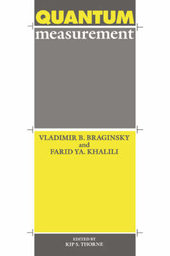
|
Quantum Measurement
Paperback / softback
Main Details
| Title |
Quantum Measurement
|
| Authors and Contributors |
By (author) Vladimir B. Braginsky
|
|
By (author) Farid Ya Khalili
|
|
By (author) Kip S. Thorne
|
| Physical Properties |
| Format:Paperback / softback | | Pages:212 | | Dimensions(mm): Height 228,Width 151 |
|
| Category/Genre | Quantum physics |
|---|
| ISBN/Barcode |
9780521484138
|
| Classifications | Dewey:530.12 |
|---|
| Audience | | Tertiary Education (US: College) | | Professional & Vocational | |
|---|
| Illustrations |
Worked examples or Exercises
|
|
Publishing Details |
| Publisher |
Cambridge University Press
|
| Imprint |
Cambridge University Press
|
| Publication Date |
25 May 1995 |
| Publication Country |
United Kingdom
|
Description
This book is an up-to-date introduction to the quantum theory of measurement. Although the main principles of the field were elaborated in the 1930s by Bohr, Schrodinger, Heisenberg, von Neuman, and Mandelstam, it was not until the 1980s that technology became sufficiently advanced to allow its application in real experiments. Quantum measurement is now central to many ultra-high technology developments, such as "squeezed light," single atom traps, and searches for gravitational radiation. It is also considered to have great promise for computer science and engineering, particularly for its applications in information processing and transfer. The book begins with a brief introduction to the relevant theory and goes on to discuss all aspects of the design of practical quantum measurement systems.
Reviews' ... applies all tools of classical and quantum measurement to the measurement of small forces. The tools include evolution operators, eigenstates, density matrices, correlation functions, noise spectral densities and hetero- and homodyne detection ... the ideas, all subtle, fundamental and useful, are the original work of the authors ... will provide easy-to-understand examples for the quantum mechanics texts of the future, and it will influence the direction of research in quantum mechanics.' Donald Searl, Physics Today
|